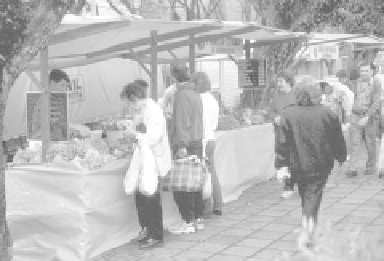Agriculture Reference
In-Depth Information
the focus of their diets. Food that cannot be grown locally
is not eliminated from what they eat, but its role is reduced
in favor of more local food. In temperate climates, this
also implies eating what is available in season and relying
more on traditional food-caching techniques such as root
cellaring, as well as food preservation and storage tech-
niques such as drying and canning. Although this means
“giving up” some of the choice and convenience we have
come to expect in the global supermarket, it brings many
benefits, including renewed connection to place.
The concept of the
watershed —
an area drained by a
single interconnected network of streams — plays a role
in discussions of bioregionalism generally. In the context
of agricultural bioregionalism, it makes sense to use the
parallel concept of the
foodshed
, which can be defined
as a geographically limited sphere of land, people, and
businesses tied together by food relationships.
Many benefits can be derived from a food system in
which foodsheds are the primary functional units. From
an ecological perspective, growing and consuming food
locally reduces the amount of fossil fuel energy needed
to transport food to the consumer. Less energy need be
expended to process or store food once it is harvested
because food can be consumed sooner following harvest.
Food waste can be more easily returned to the farm,
promoting nutrient cycling and reducing the dependence
on outside nutrient inputs. Diversity at the level of the
farm (Chapter 16) and the level of the landscape (Chapter
22) is more easily supported, creating a healthy integra-
tion of urbanized areas, working landscapes, and natural
ecosystems.
Economically, local economies thrive on local food sys-
tems. Money spent on locally grown food can generate
nearly twice as much income for the local economy as
money spent on food from afar (Halweil, 2004). Money
recirculates within the community rather than being
siphoned off by distant companies. All sectors of the com-
munity benefit from this local flow: local farmers, local
businesses, local service agencies, and even local schools
and hospitals. Bioregionally based agriculture, therefore, is
the key element in any effort to rebuild and restore economi-
cally and socially distressed rural communities and regions.
requires food supply chains with fewer links. The impor-
tance of
short food supply chains
, or SFSCs, has been
recognized in the area of rural development (Renting et al.,
2003), and the concept is gaining attention as a component
of food-system sustainability.
The shortest food supply chain is not even a chain
because it has no links at all: consumption of food by the
same person, family, or group who grew it. Although
growing one's own food is often rejected as impractical,
it is practiced to a surprising extent all over the world,
even in urban settings. From cities in China to towns all
over Europe, the backyard or rooftop kitchen garden is an
important source of food. Community gardens
—
provid-
ing gardening plots for those without access to land
—
are common in cities around the world, and are becoming
increasingly popular in U.S. and Western Europe.
The next shortest food-supply chain, of course, is pro-
vided by a direct relationship between farmer and consumer.
These face-to-face chains occur with farmers' markets, box
schemes, roadside sales, farm stores, pick-your-own farms,
and the like (Figure 23.5).
Traditional food-retailing arrangements can incorpo-
rate shorter food supply chains, too, particularly when
restricted to a local foodshed. Supermarkets, food stores,
restaurants, and institutions can purchase a large portion
of their food direct from local growers. This adds only
one link between farmer and consumer. Even if a distribu-
tor or other wholesaler is involved, the links are still fewer
than those that exist in the global food system, and the
distance the food travels is greatly reduced.
Finally, direct or nearly direct farmer-consumer
commerce can occur over greater distances, facilitated by
present-day communication technology and the transpor-
tation infrastructure. Through direct-purchase coopera-
tives, e-commerce, and subscription plans, consumers can
buy high-value products, such as coffee, directly from the
farmers who grow them. Even though the products may
travel long distances, the long food supply chain of the
global food system is effectively short circuited.
Shorter Food Supply Chains
One of the problematic aspects of the present global
food system is the large number of “links” in the chain
between the farmer and consumer. These often include
brokers, processors, distributors, transporters, packagers,
wholesalers, and retailers. The greater the number of links,
the more disconnected the farmer and consumer, the
greater the amount of the consumer food dollar siphoned
away from the farmer, and the greater the demand for food
production to be large scale and driven solely by produc-
tion criteria. A more sustainable alternative food system
FIGURE 23.5
A rural farmer's association selling organic
produce at a market in Porto Alegre, Brazil.
More than a
dozen farmers own a truck together and take turns going to the
market with their pooled products.

Search WWH ::

Custom Search